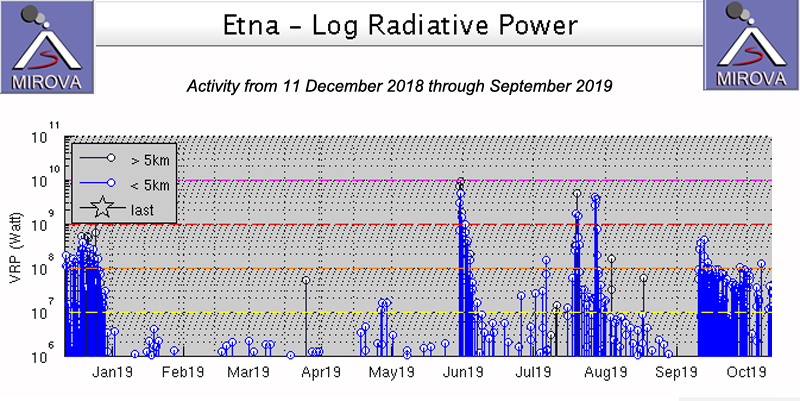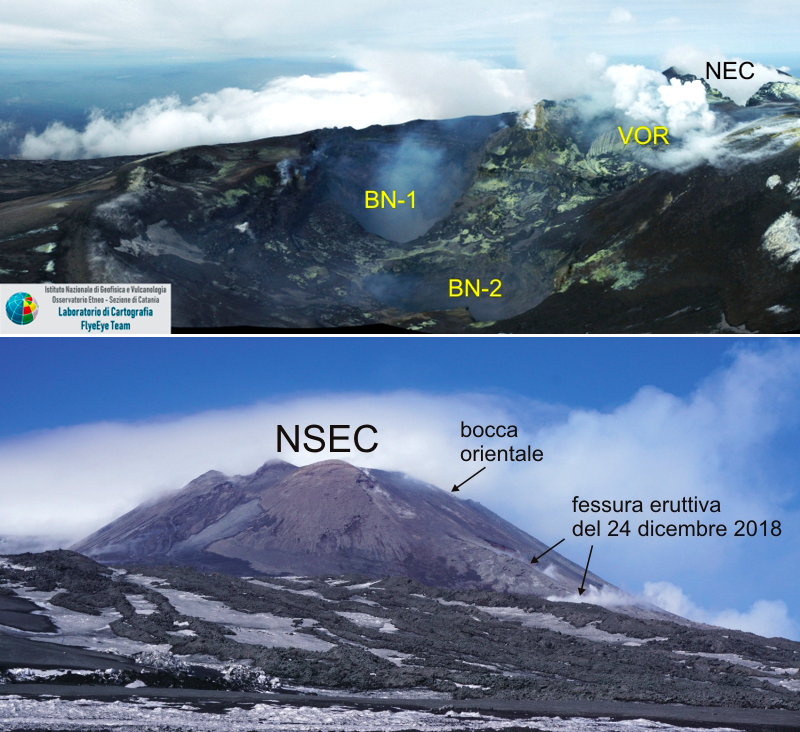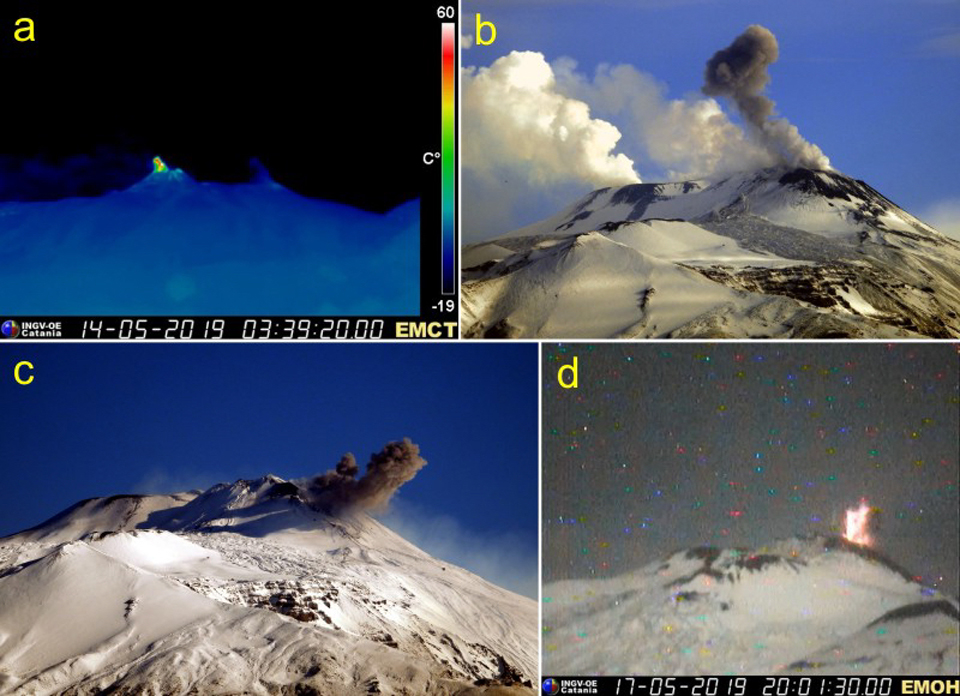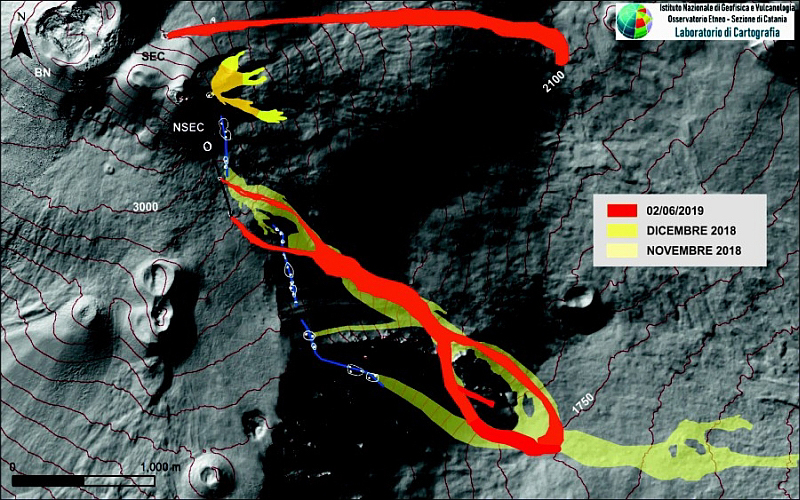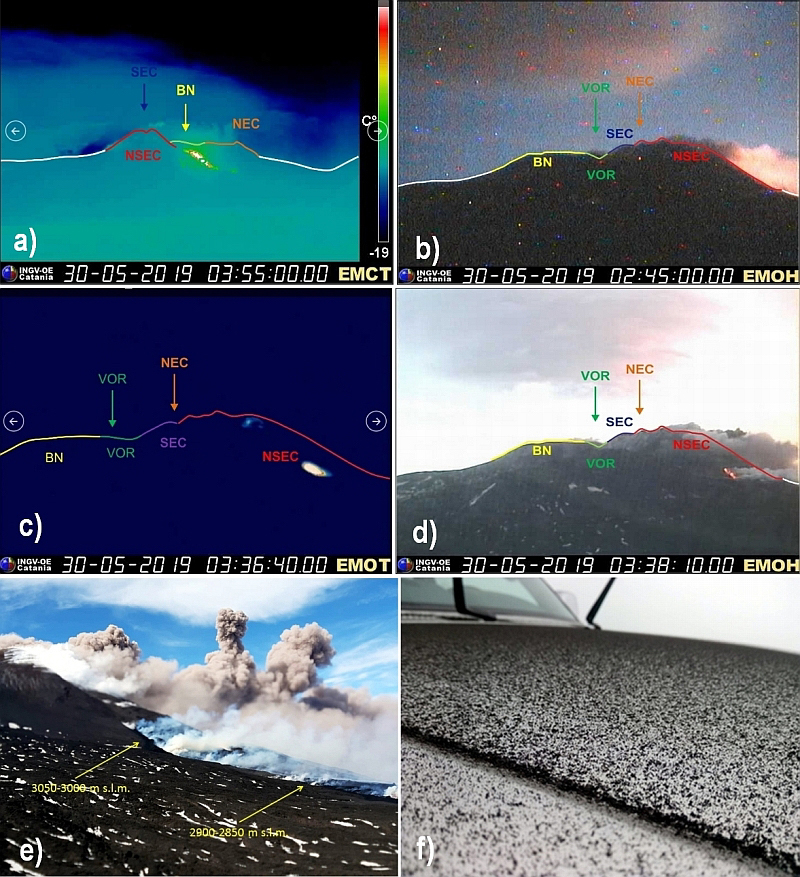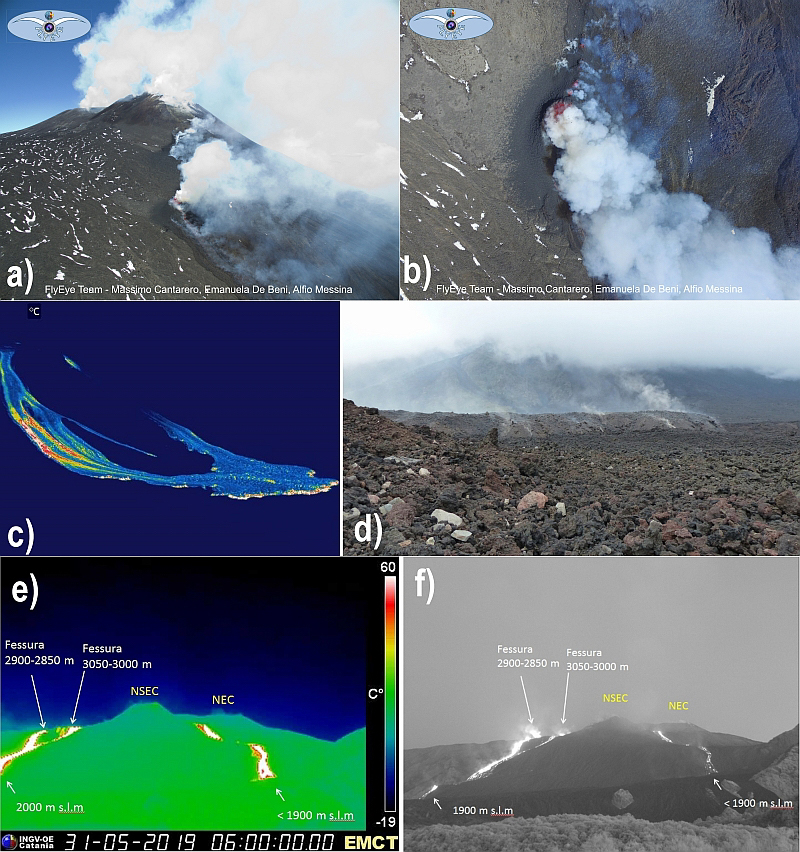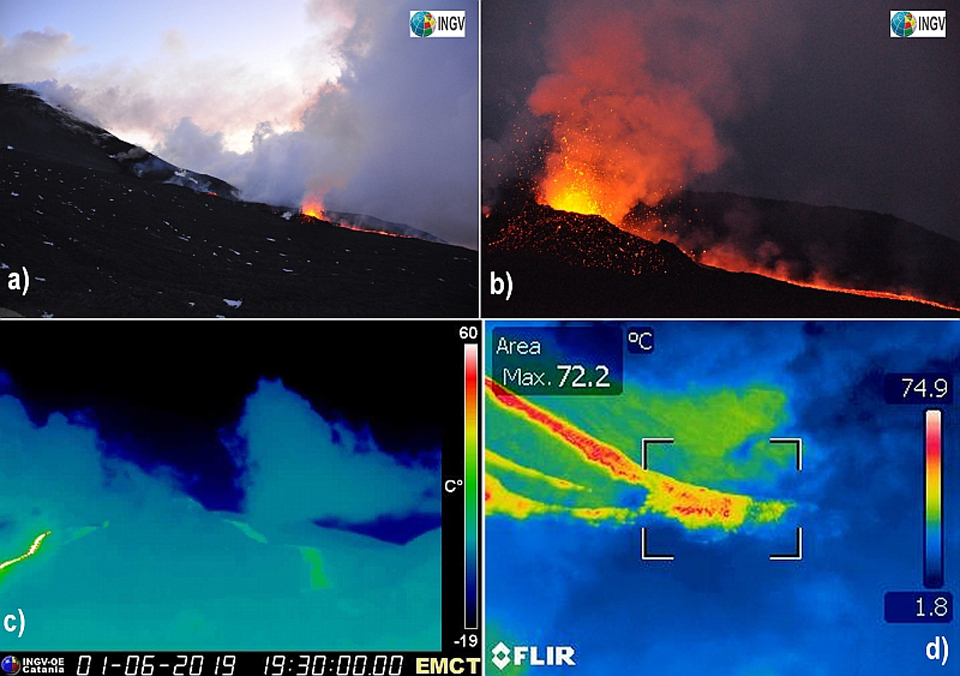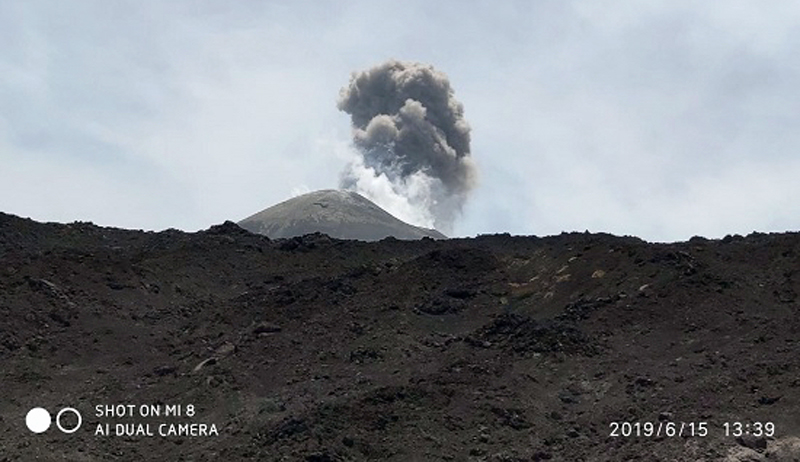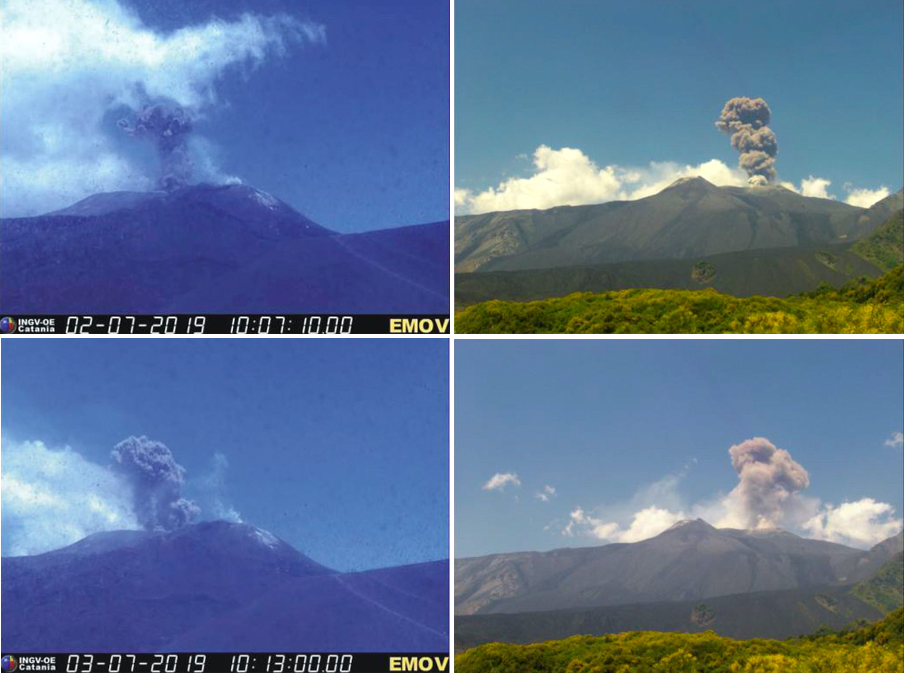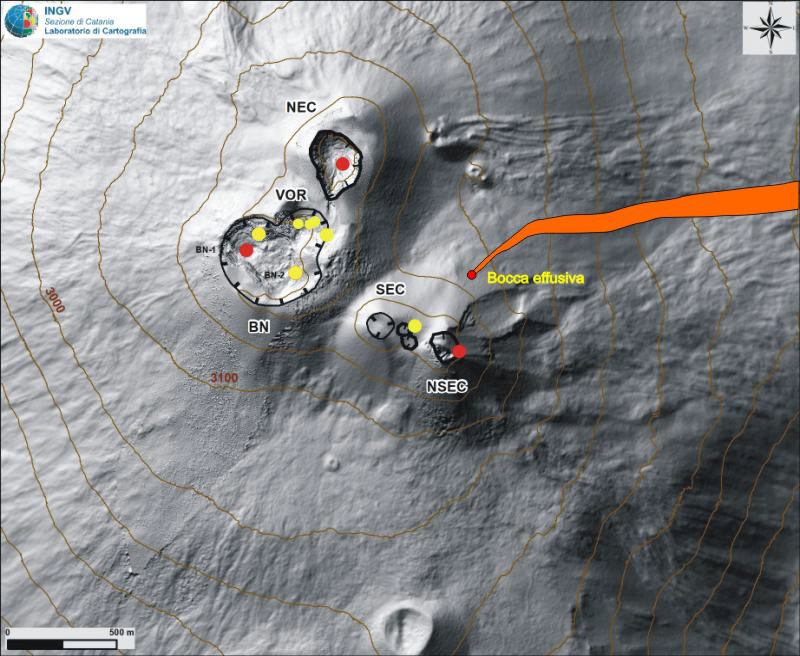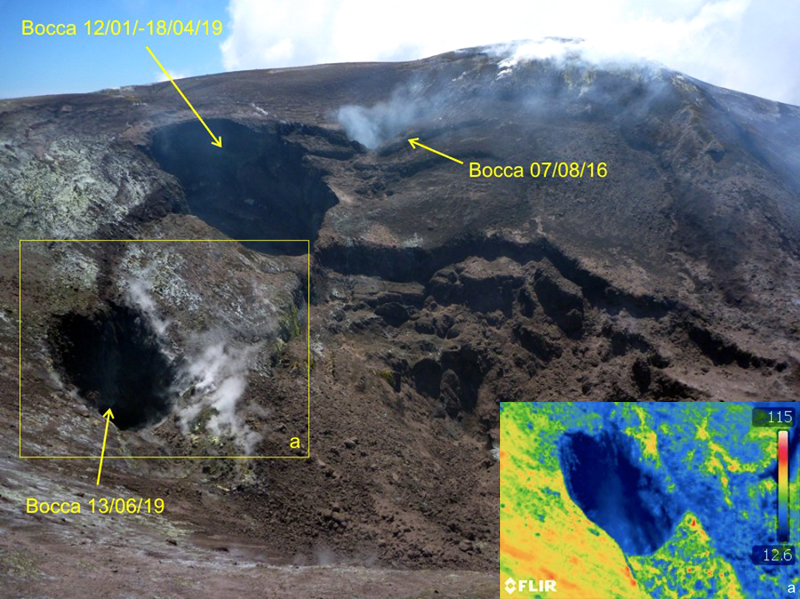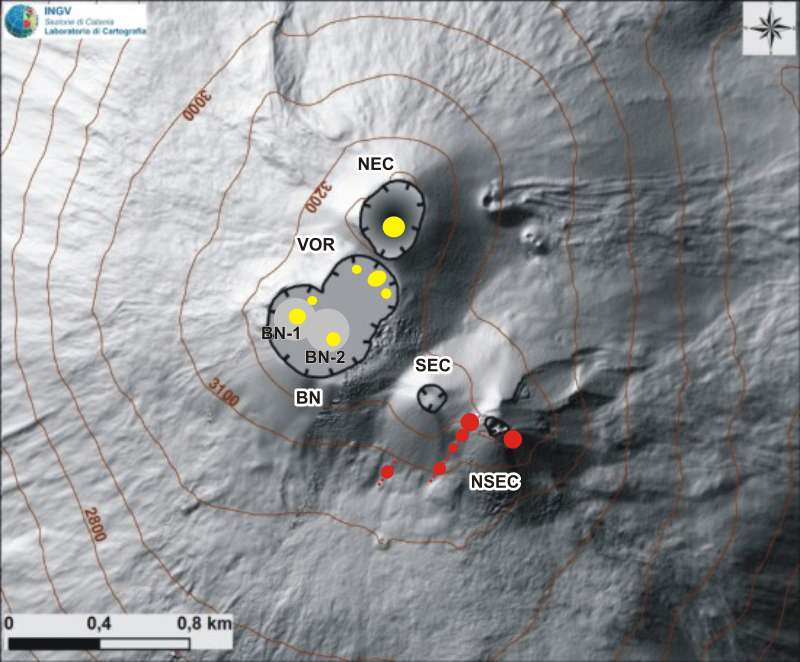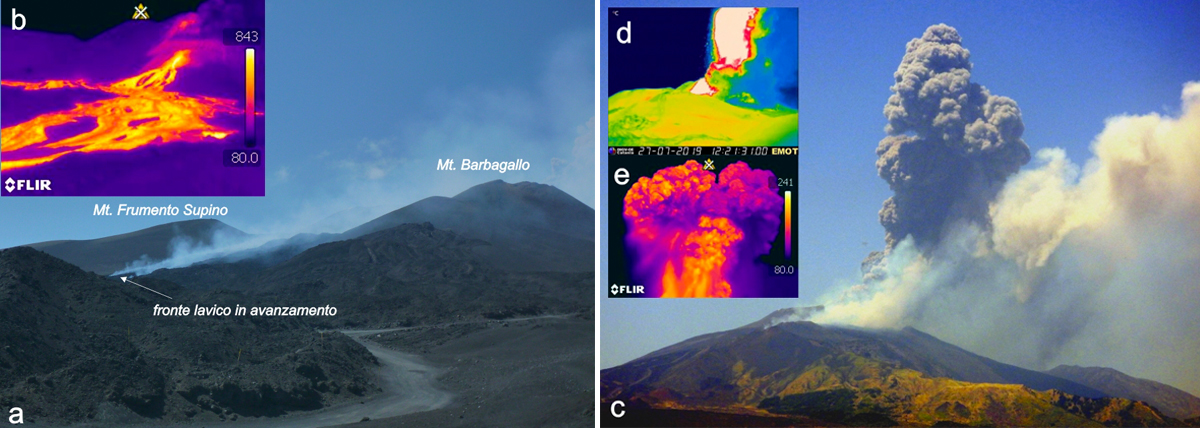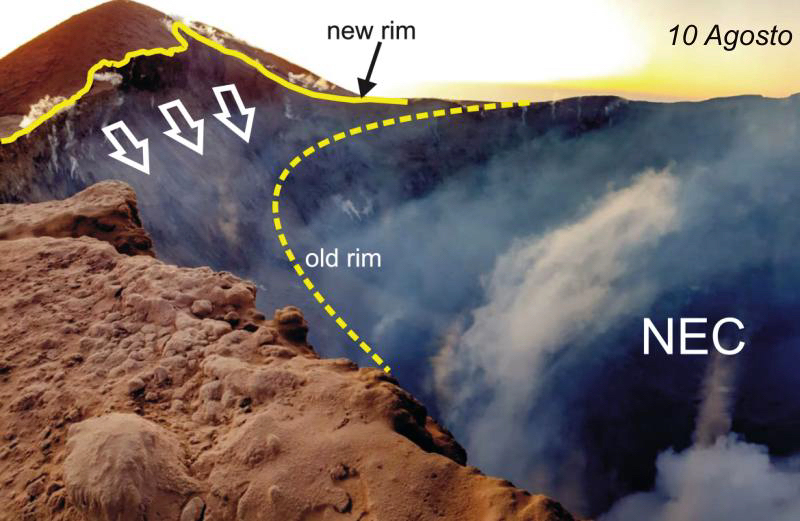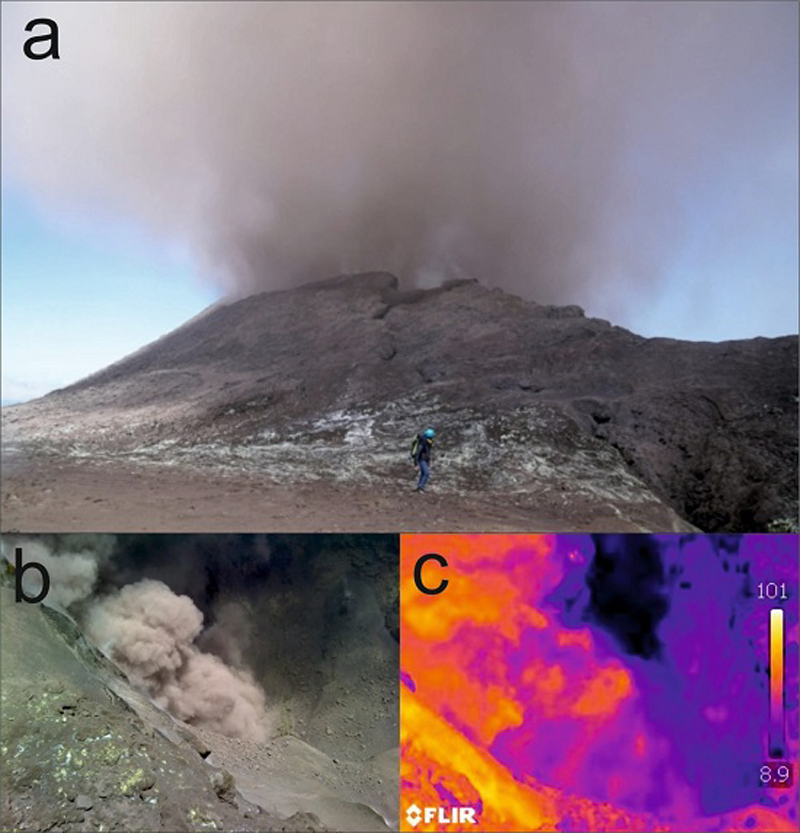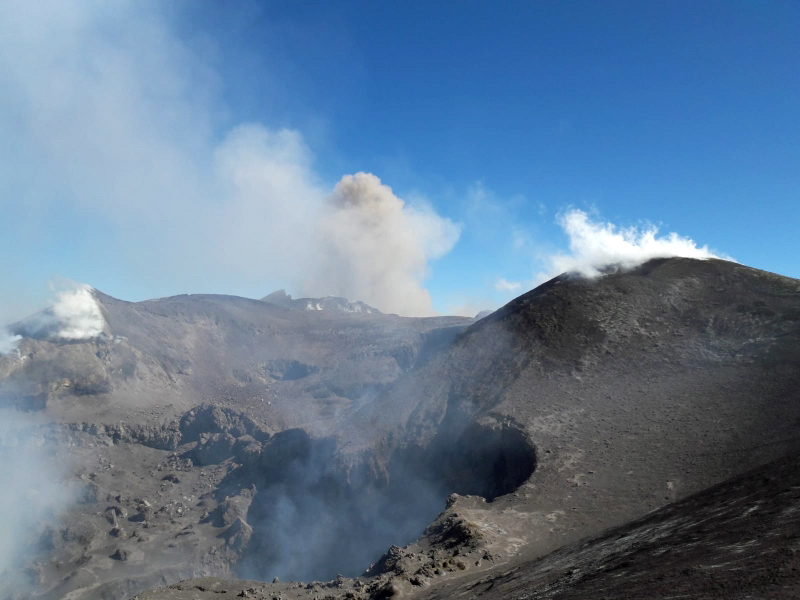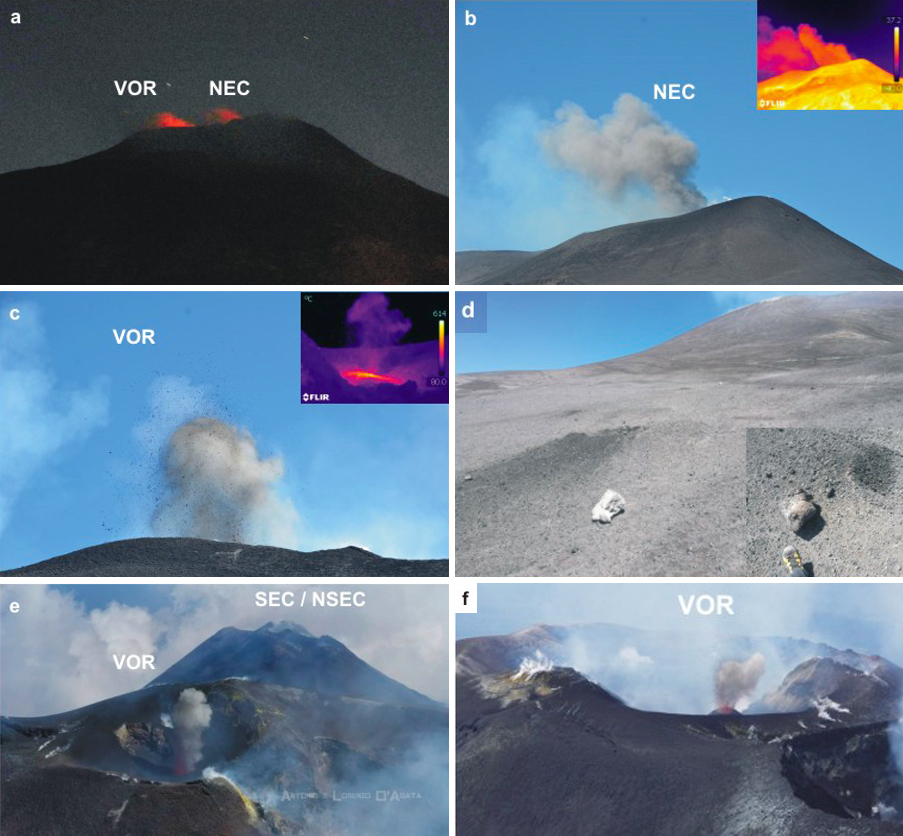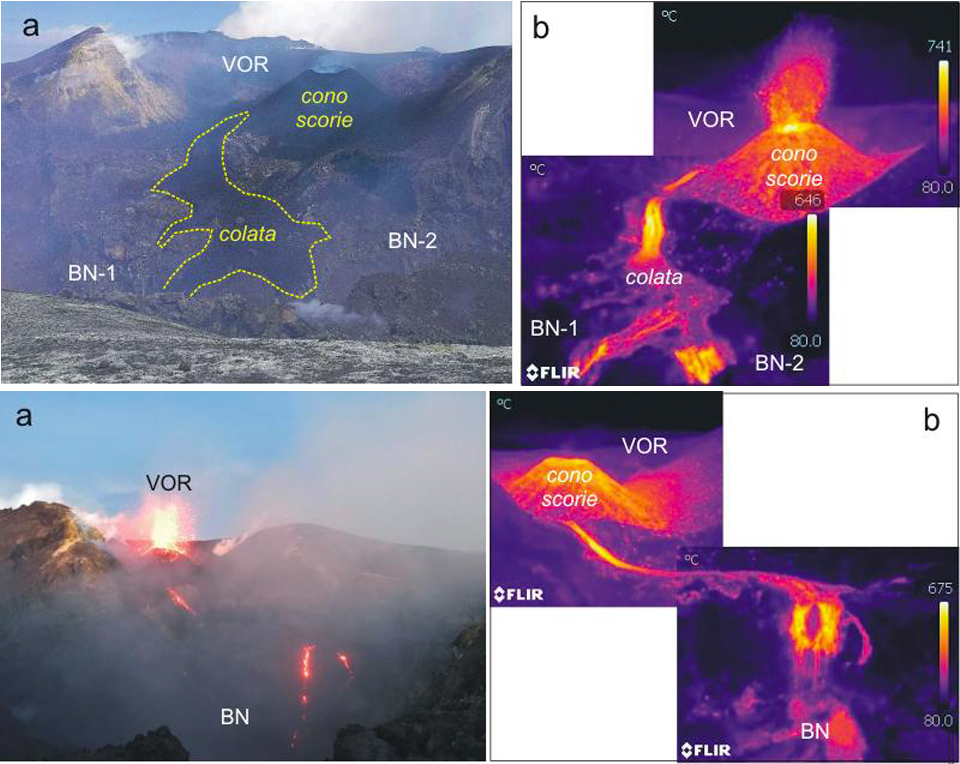Report on Etna (Italy) — October 2019
Bulletin of the Global Volcanism Network, vol. 44, no. 10 (October 2019)
Managing Editor: Edward Venzke.
Edited by A. Elizabeth Crafford.
Etna (Italy) Five lava flows and numerous ash plumes and Strombolian explosions, April-September 2019
Please cite this report as:
Global Volcanism Program, 2019. Report on Etna (Italy) (Crafford, A.E., and Venzke, E., eds.). Bulletin of the Global Volcanism Network, 44:10. Smithsonian Institution. https://doi.org/10.5479/si.GVP.BGVN201910-211060
Etna
Italy
37.748°N, 14.999°E; summit elev. 3357 m
All times are local (unless otherwise noted)
Italy's Mount Etna on the island of Sicily has had historically recorded eruptions for the past 3,500 years and has been erupting continuously since September 2013 through at least September 2019. Lava flows, explosive eruptions with ash plumes, and Strombolian lava fountains commonly occur from its summit areas that include the Northeast Crater (NEC), the Voragine-Bocca Nuova (or Central) complex (VOR-BN), the Southeast Crater (SEC, formed in 1978), and the New Southeast Crater (NSEC, formed in 2011). The newest crater, referred to as the "cono della sella" (saddle cone), emerged during early 2017 in the area between SEC and NSEC. Varying activity that included several lava flows, Strombolian activity, and numerous ash plumes from most of the active summit vents and several flank fissures occurred during April-September 2019, the period covered in this report, with information provided primarily by the Osservatorio Etneo (OE), part of the Catania Branch of Italy's Istituo Nazionale di Geofisica e Vulcanologica (INGV).
Degassing of variable intensity was typical activity from all the vents at Etna during much of April 2019. Intermittent ash emission and Strombolian activity occurred at Bocca Nuova, especially during the last week. Minor ash emissions were reported from NEC and NSEC the last week as well. Most of the activity at the summit during May 2019 was focused around the New South East Crater (NSEC); repeated Strombolian activity was witnessed from the E vent near the summit throughout the month. Beginning on 30 May, two fissures opened on the N and SE flanks of NSEC and produced lava flows that traveled E and SE across the W wall of the Valle del Bove. The flows ceased during the first week of June; activity for the rest of that month consisted of intermittent explosions with small ash plumes from Voragine and Bocca Nuova. Discontinuous Strombolian explosions and isolated ash emissions from NEC, NSEC, and Bocca Nuova characterized activity during the first half of July 2019; the explosions intensified at NSEC later in the month. A lava flow emerged from the lower NE flank of NSEC on 18 July that lasted for several days. Explosions produced substantial ash plumes from the NSEC summit crater, causing ashfall nearby, and a new flow emerged from a fissure on the S flank of NSEC on 27 July.
Explosions with intermittent ash emissions during August 2019 were focused primarily on the North East Crater (NEC), with occasional ash emissions from Bocca Nuova. These continued into early September. Activity increased to include Strombolian explosions with the ash emissions at NEC, Bocca Nuova, and Voragine where a scoria cone formed deep within the crater from continued Strombolian activity. A lava flow emerged from the base of the scoria cone on 18 September and was active for about four days, sending branches of lava into multiple areas of the adjacent Bocca Nuova crater. Ash emissions at NEC continued during the end of the month. The multiple episodes of varying activity during the period were reflected in the MIROVA thermal energy data; spikes of thermal activity that corresponded to periods of lava effusion were apparent late May-early June, multiple times in July, and during the second half of September (figure 260).
Activity during April-May 2019. During a site visit to the summit on 1 April scientists from INGV noted weak degassing from both pit craters, BN-1 and BN-2, within Bocca Nuova (BN); the Voragine (VOR) and North East Crater (NEC) were emitting abundant steam and gas emissions. The New Southeast Crater (NSEC) also had significant fumarolic activity concentrated primarily on the crater rim along with gas plumes visible from both the E vent and the 24 December 2018 flank fissure (figure 261). A brief episode of ash emission was observed from BN on the morning of 8 April. Persistent pulsating flashes of incandescence were noted at the E vent of NSEC during the second week. A new vent was observed in the inner wall of the Voragine crater during an inspection on 19 April, located immediately below the vent which formed on 12 January 2019 (figure 262). During the last week of April there were ten episodes of ash emission from BN, two from NEC, and one produced by the E vent at NSEC. Strombolian activity was observed on the morning of 28 April at BN-1, and persistent incandescence was visible from the E vent of NSEC. Early on 30 April both BN-1 and BN-2 were producing explosions every few seconds. Coarse ejecta (lapilli and bombs) rose higher than the crater rim; most fell back within the crater, but some material was observed on the rim the following day.
Activity at the summit during May 2019 was focused around the New South East Crater (NSEC). Discontinuous Strombolian activity was observed at the E vent of NSEC early on 2 May accompanied by ash emissions from the summit vent that rose about 1,000 m (figure 263). Explosion frequency increased beginning on 5 May with weak and discontinuous ash emissions reported from the NSEC summit for the next several days; ash emissions were also observed from the Saddle vent and the NSEC E vent during 6-8 May. In addition to ash emissions and Strombolian activity continuing from both the summit and E vents at NSEC during the third and fourth weeks, overnight on 17-18 May several larger Strombolian explosions sent pyroclastic ejecta tens of meters above the crater rim (figure 264). The explosion intervals ranged from a few minutes to a few hours. The new vent that had formed at Voragine in mid-April coalesced with the 12 January vent during the second week of May; dilute ash was observed from the BN-1 vent on 23 May.
A fissure opened at the base of the N flank of NSEC shortly after midnight on 30 May 2019 at an elevation of about 3,150 m (figure 265). It produced mild explosive activity and a lava flow that spread towards the W wall of the Valle del Bove. By 0800 UTC the flow had reached an elevation of 2,050 m. A second fissure opened at 0335 the same morning at the base of the SE flank of NSEC at an elevation of 3,050 m. The lava flowed along the W wall of the Valle del Bove towards Serra Giannicola Grande and had reached an elevation of 2,260 m by 0815. Strong winds dispersed ash emissions from the fissures to the NE for much of the day; ashfall occurred in Linguaglossa (figure 266). The Toulouse VAAC reported an ash plume drifting ENE at 3.9 km altitude on 30 May. Samples of the ash that were collected and analyzed were shown to be about 70% lithic clasts, 25% crystals, and about 5% juvenile material. It became clear the next day that two vents along the SE-flank fissure initially produced separate flows that coalesced into a single flow which expanded along the W wall of Valle del Bove. By 0830 on 31 May that flow had reached an elevation of 1,700 m at the base of Serra Giannicola Grande. The fissure at the base of the N flank continued to propagate along the W wall of Valle del Bove also, and had reached an elevation of 2,050 near Monte Simone by 1030 on 31 May (figure 267). When the new eruptive activity began on 29 May, inclinometers measured slight but prolonged deflation of the volcano.
Activity during June-July 2019. The flow from the N flank of NSEC ceased advancing on 1 June 2019, but the active spattering continued from the fissure on the SE flank for a few more days. The SE-flank flow had reached 1,700 m elevation in the Valle del Bove by the afternoon of 2 June (figure 268). The intensity and frequency of the explosions decreased over the next few days, with the active flow front receding back towards the vent until it stopped moving on 6 June. The NE rim of the summit cone at NSEC appeared lowered by several meters after the eruption ceased. The lava flows and explosions of 30 May-2 June produced persistent SO2 emissions that drifted E and N for over 800 km (figure 269).
Activity for the rest of June 2019 moved to the other craters, mainly Voragine, after the flows ceased at NSEC. On the morning of 6 June there were sporadic ash emissions from NEC that quickly dissipated. A small ash plume appeared from Bocca Nuova (BN) on 11 June. An explosive sequence that began on 13 June from the crater floor of Voragine continued intermittently through the third week of the month (figure 270) and produced several small ash plumes. A new vent opened on the crater floor and produced a small ash plume; ejecta also landed on the crater rim several times. On 22 June small, discontinuous ash emissions were produced from BN-1; they dispersed rapidly, but intermittent explosions continued during the following week. By the end of the month, only BN was exhibiting activity other than degassing; incandescence from the crater was seen during the night of 24 June and three isolated ash emissions were seen in the webcams on 26 June.
Discontinuous Strombolian explosions and isolated ash emissions characterized activity during the first half of July 2019. Pulsating degassing from NEC produced ash emissions on 2 and 3 July (figure 271), and incandescence on 4 and 5 July. Intense degassing was observed at NSEC during 1-5 July, this turned into isolated ash emissions and Strombolian activity on 5 and 6 July from the E vent with explosions occurring every 1-5 minutes; the ejecta landed on the upper E flank. Dilute ash emissions were observed from Bocca Nuova on 6 July. NEC produced two major ash emissions on the evening of 8 July and the late morning of 13 July. The ash plumes quickly dispersed in the summit area. Strombolian activity at the E vent of NSEC was witnessed on 14 July. Explosive activity at Bocca Nuova remained deep within the crater during mid-July. Steam produced by the 13 June 2019 vent on the floor of Voragine occasionally contained dilute ash. During 15-17 July sporadic explosions were observed at NSEC accompanied by small puffs of ash that rapidly dispersed.
Beginning early on 18 July, Strombolian activity increased at NSEC from an explosion every 1-2 minutes to multiple explosions per minute in the following hours. Continuous activity during the evening decreased sharply around 2200. About an hour later visual and thermal surveillance cameras on Monte Cagliato recorded the opening of a vent on the lower NE flank of NSEC; lava slowly advanced from the vent towards Valle del Leone (figures 272 and 273). Explosive activity resumed at the NSEC summit a few hours later, accompanied by occasional ash emissions from NEC and Bocca Nuova. Explosions tapered off briefly by noon on 19 July, but a sudden increase in explosive activity during the afternoon of 19 July produced Strombolian activity and sporadic ash emissions from three vents inside the NSEC crater. Ashfall was reported that evening in communities on the S flank of Etna. The Toulouse VAAC reported significant ash above the summit at 3.7 km altitude. Activity declined again later that evening at NSEC, but abundant ash emission began at NEC that lasted until the morning of 20 July. A new phase of explosive activity began at NSEC around 0700 on 20 July with an ash plume and an increase in lava emission from the vent on the NE flank (figure 274). By the evening of 20 July only a small amount of material was feeding the lava flow; the farthest advanced fronts were at an elevation around 2,150 m, above Monte Simone. A few small ash emissions were observed at Bocca Nuova on 21 July.
Visible and thermal images taken on 24 July 2019 indicated only degassing at BN-1 and BN-2, and limited degassing from low-temperature fumaroles from the multiple vents at VOR (figure 275). After a few days of quiet, NSEC resumed discontinuous ash emissions on 25 July. A sudden increase in the amplitude of volcanic tremor was noted early on 27 July, which was followed a few hours later by the opening of a new eruptive fissure on the S flank of NSEC (figure 276). Explosive activity intensified and produced a dense ash-rich plume that dispersed to the E at an estimated altitude of 4.5-5 km. A thin layer of ash was reported in Giarre, Riposto, and Torre Archirafi. A lava flow emerged from the S portion of the fissure and expanded SW and S. By 1135 the most advanced front had reached and passed the N side of the base of the Barbagallo Mountians at an elevation of about 2,850 m. It continued to spread down into the area between Monte Frumento Supino and the pyroclastic cones of 2002-2003 (figure 277). A series of particularly strong explosions occurred from NSEC around midday, producing an ash plume that rose to 7.5 km altitude. By this time the most advanced lava fronts were located at an elevation of about 2,600 m, but they were rapidly advancing SSW towards Monte Nero, surrounding Monte Frumento Supino from the W. Explosive activity decreased significantly early in the morning on 28 July; flow activity also slowed around the same time. Occasional puffs of reddish-brown ash were noted from NEC during the morning as well. The explosions and the lava effusion ceased on the evening of 28 July. An isolated ash emission from Bocca Nuova in the early hours of 31 July was the last activity reported in July. A substantial SO2 plume (6.59 DU) from the explosions on 27 July had drifted to the E coast of the Adriatic Sea by midday on 28 July and was detected in satellite instruments.
Activity during August-September 2019. Activity during August 2019 was focused primarily on the North East Crater (NEC), with occasional ash emissions from Bocca Nuova. The plumes were occasionally dense and dark brown from NEC. Weak emissions of dilute ash from NEC quickly dispersed on the morning of 4 August, followed by more intermittent ash emissions during 6-10 August; a few had significant concentrations of ash that drifted SE. Part of the N rim of NEC collapsed during the explosions of early August (figure 278). During a site inspection to the summit by INGV personnel on 16 August, continuous degassing at Bocca Nuova was interrupted every 10-15 minutes by explosions, but no ejecta was noted. Discontinuous emissions from NEC formed small ash plumes that rose a few hundred meters and remained in the summit area (figure 279). Thermal surveys that day indicated high temperatures of about 800°C along a 10-m-fracture zone on the northern rim of VOR. Ash emissions from NEC were persistent through 20 August when they decreased significantly; a few explosions had dilute ash emissions from Bocca Nuova that day and the next (figure 280). Sulfur dioxide emissions were notable during 19-22 August, drifting S and W hundreds of kilometers before dissipating. Isolated and dilute ash from NEC early on 28 August was interpreted by INGV as resulting from collapses along the inner crater walls. During site inspections on 27, 28, and 30 August, deep explosions from Bocca Nuova were heard, and degassing was observed at all of the summit vents.
Activity during September 2019 began with discontinuous and dilute ash emissions from NEC and Bocca Nuova, as well as episodes of Strombolian activity at both vents. This was followed by increased Strombolian activity, ash emissions, and a lava flow at Voragine. Isolated ash emissions occurred at NEC and VOR on 4 and 5 September. Sporadic deep explosions were heard from BN-1 during a site inspection on 7 September. Overnight during 7-8 September the visual webcams recorded incandescence at NEC and pyroclastic ejecta observed outside the crater rim that coincided with increased tremor activity. A more intense episode of Strombolian activity began the following evening at NEC. Activity was continuous from 1800 on 9 September to 0500 on 10 September, and produced dilute ash emissions that quickly dispersed (figure 281). Slight ashfall was reported in Piedimonte Etneo, Giarre-Riposto, and Rifugio Citelli. Continuous puffs of dilute ash were observed beginning at dawn on 11 September with sporadic ejecta again landing outside the crater rim. Significant SO2 plumes were measured by satellite instruments on 10 and 11 September (figure 282).
In addition to the Strombolian activity at NEC on 12 September, ash emissions began that morning at VOR. They increased in frequency and then transitioned to near-continuous Strombolian activity that produced ejecta which landed in the base of the adjacent Bocca Nuova crater. The explosions from the Strombolian activity were felt in Zafferana Etnea, Aci S. Antonio, Pedara, and neighboring areas. On 13 September the webcams observed multiple periods of continuous ash emissions from NEC and short, intense pulses of ash from VOR that accompanied Strombolian activity; coarse ejecta rose 20 m above and landed outside of the crater rim, producing impact craters on the W side of the summit between VOR and BN. The vent that sourced the Strombolian activity was located in the deepest part of the Voragine crater. By 15 September, continued ejecta had formed a scoria cone around the vent inside VOR (figure 283).
Explosive activity inside VOR increased on the afternoon of 18 September 2019. Pyroclastic ejecta and ash erupted from several vents and reached heights of several tens of meters. A lava flow emerged from the W base of the scoria cone and headed S, advancing several hundred meters (figure 284). It then flowed over the saddle that divides VOR and BN, split into two branches, and entered Bocca Nuova. One stream poured into BN-1, and another stopped near the edge of the BN-2 pit crater. By 22 September the flow was cooling, but strong Strombolian activity continued inside Voragine. NEC was characterized by large-scale ash emissions during the end of September, including one in the morning of 27 September that sent a plume over the S flank of Etna before dissipating (figure 285). Strombolian activity continued within Bocca Nuova during the last week of the month.
Geological Summary. Mount Etna, towering above Catania on the island of Sicily, has one of the world's longest documented records of volcanism, dating back to 1500 BCE. Historical lava flows of basaltic composition cover much of the surface of this massive volcano, whose edifice is the highest and most voluminous in Italy. The Mongibello stratovolcano, truncated by several small calderas, was constructed during the late Pleistocene and Holocene over an older shield volcano. The most prominent morphological feature of Etna is the Valle del Bove, a 5 x 10 km caldera open to the east. Two styles of eruptive activity typically occur, sometimes simultaneously. Persistent explosive eruptions, sometimes with minor lava emissions, take place from one or more summit craters. Flank vents, typically with higher effusion rates, are less frequently active and originate from fissures that open progressively downward from near the summit (usually accompanied by Strombolian eruptions at the upper end). Cinder cones are commonly constructed over the vents of lower-flank lava flows. Lava flows extend to the foot of the volcano on all sides and have reached the sea over a broad area on the SE flank.
Information Contacts: Sezione di Catania - Osservatorio Etneo, Istituto Nazionale di Geofisica e Vulcanologia (INGV), Sezione di Catania, Piazza Roma 2, 95123 Catania, Italy (URL: http://www.ct.ingv.it/it/ ); MIROVA (Middle InfraRed Observation of Volcanic Activity), a collaborative project between the Universities of Turin and Florence (Italy) supported by the Centre for Volcanic Risk of the Italian Civil Protection Department (URL: http://www.mirovaweb.it/); Global Sulfur Dioxide Monitoring Page, Atmospheric Chemistry and Dynamics Laboratory, NASA Goddard Space Flight Center (NASA/GSFC), 8800 Greenbelt Road, Goddard, Maryland, USA (URL: https://so2.gsfc.nasa.gov/); Toulouse Volcanic Ash Advisory Center (VAAC), Météo-France, 42 Avenue Gaspard Coriolis, F-31057 Toulouse cedex, France (URL: http://www.meteo.fr/aeroweb/info/vaac/).


